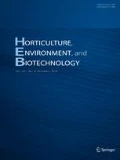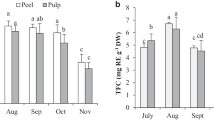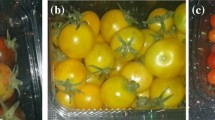Abstract
The vast majority of the tomato crop is harvested at mature green stage and ripened off of the plant for fresh market consumption. The other large amount of crop is harvested when the fruit has reached to fully mature red stage which is called “vine-ripened”. Here we attempt to answer and clarify if there is any difference between the antioxidant capacity of postharvest ripened and vine ripe tomatoes. Greenhouse grown tomatoes (cv. Newton) were harvested at four different ripening stages of unripe and vine ripe. Total phenolic (TP) contents and antioxidant capacity by the FRAP (ferric reducing antioxidant power) and TEAC (trolox equivalent antioxidant capacity) assays were performed on all ripening stages. Results of the present study demonstrated that tomato peel has significantly higher TP content and antioxidant capacity than the pulp tissues in all maturity stages tested. TP and antioxidant capacity of tomato fruits were affected during postharvest ripening process. If only pulp tissue considered, TAC of vine-ripened and postharvest ripened pink tomatoes has similar amount, but significantly higher content than mature green, breaker and turning maturity stages. If peel tissue measured, the mean separations identified three groups. Postharvest ripened mature green stage has the most TAC, followed by vine-ripened and pink stage. Postharvest breaker and turning stages have the least amount of TAC.
Similar content being viewed by others
Literature Cited
Benzie, I.F.F. and J.J. Strain. 1996. The ferric reducing ability of plasma (FRAP) as a measure of “antioxidant power”: The FRAP assay. Anal. Biochem. 239:70–76.
Buta, J.G and D.W. Spaulding. 1997. Endogenous levels of phenolics in tomato fruit during growth and maturation. J. Plant Growth Regul. 16:44–46.
Chandra, H.M. and S. Ramalingam. 2011. Antioxidant potentials of skin, pulp, and seed fractions of commercially important tomato cultivars. Food Sci. Biotechnol. 20:15–21.
Choi, S.H., S.H. Lee, H.J. Kim, I.S. Lee, K. Nobuyuki, C.E. Levin, and M. Friedman. 2010. Changes in free amino acid, phenolic, chlorophyll, carotenoid, and glycoalkaloid contents in tomatoes during 11 stages of growth and inhibition of cervical and lung human cancer cells by green tomato extracts. J. Agric. Food Chem. 58:7547–7556.
Food and Agricultural Organization of the United Nations (FAO). 2009. Crop production tomato FAOSTAT. http://faostat.fao.org/site/567/DesktopDefault.aspx?PageID=567.
Friedman, M., C.E. Levin, S.U. Lee, H.J. Kim, I.S. Lee, J.O. Byun, and N. Kozukue. 2009. Tomatine-containing green tomato extracts inhibit growth of human breast, colon, liver, and stomach cancer cells. J. Agric. Food Chem. 57:5727–5733.
George, B., C. Kaur, D.S. Khurdiya, and H.C. Kapoor. 2004. Antioxidants in tomato (Lycopersicon esculentum) as a function of genotype. Food Chem. 84:45–51.
George, S., F. Tourniaire, H. Gautier, P. Goupy, E. Rock, and C. Caris-Veyrat. 2011. Changes in the contents of carotenoids, phenolic compounds and vitamin C during technical processing and lyophilisation of red and yellow tomatoes. Food Chem. 124:1603–1611.
Giovanelli, G., V. Lavelli, C. Peri, and S. Nobili. 1999. Variation in antioxidant components of tomato during vine and post-harvest ripening. J. Sci. Food Agr. 79:1583–1588.
Gündüz, K. and Saraçoğlu, O. 2012. Variation in total phenolic content and antioxidant activity of Prunus cerasifera Ehrh. selections from Mediterranean region of Turkey. Sci. Hortic. 134:88–92.
Jesús Periago, M., J. García-Alonso, K. Jacob, A. Belén Olivares, M. José Bernal, M. Dolores Iniesta, C. Martínez, and G. Ros. 2009. Bioactive compounds, folates and antioxidant properties of tomatoes (Lycopersicum esculentum) during vine ripening. Int. J. Food Sci. Nutr. 60:694–708.
Kozukue, N. and M. Friedman. 2003. Tomatine, chlorophyll, β-carotene and lycopene content in tomatoes during growth and maturation. J. Sci. Food Agric. 83:195–200.
Martinez-Valverde, I., M. Periago, G. Provan, and A. Chesson. 2002. Phenolic compounds, lycopene and antioxidant activity in commercial varieties of tomato (Lycopersicon esculentum). J. Sci. Food and Agric. 82:323–330.
Nguyen, M.L. and S.J. Schwartz. 1999. Lycopene: Chemical and biological properties. Food Technol. 53:38–45.
Ozgen, S. and S. Sekerci. 2011. Effect of leaf position on the distribution of phytochemicals and antioxidant capacity among green and red lettuce cultivars. Spanish. J. Agric. Res. 9:801–809.
Özgen, M, R.N. Reese, A.Z. Tulio, A.R. Miller, and J.C. Scheerens. 2006. Modified 2,2-Azino-bis-3-ethylbenzothiazoline-6-sulfonic acid (ABTS) method to measure antioxidant capacity of selected small fruits and comparison to ferric reducing antioxidant power (FRAP) and 2,20-diphenyl-1-picrylhydrazyl (DPPH) Methods. J. Agric. Food Chem. 54:1151–1157.
Özgen, M., A.A. Torun, S. Erci li, and S. Serçe. 2009. Changes in chemical composition, antioxidant activities and total phenolic content of arbutus andrachne fruits at different maturation stages. Italian J. Food Sci. 21:65–72.
Pek, Z., L. Helyes, and A. Lugasi. 2010. Color changes and antioxidant content of vine and postharvest-ripened tomato fruit. Hortscience 45:466–468.
Riggi, E., C. Patane, and G. Ruberto. 2008. Content of carotenoids at different ripening stages in processing tomato in relation to soil water availability. Aust. J. Agric. Res. 59:348–353.
Senter, S.D., R.J. Horvat, and W.R. Forbus. 1988. Quantitative variation of total phenols in fresh market tomatoes at three stages of maturity. J. Food Sci. 53:639–640.
Setser, C.S. 1984. Color: Reflections and transmissions. J. Food Qual. 6:183–197.
Singleton, V.L. and J.L. Rossi. 1965. Colorimetry of total phenolics with phosphomolybdic-phosphotungstic acid reagents. Am. J. Enol. Viticult. 16:144–158.
Stahl, W., U. Heinrich, S. Wiseman, O. Eichler, H. Sies, and H. Tronnier. 2001. Dietary tomato paste protects against ultraviolet light-induced erythema in humans. J. Nutr. 131:1449–1451.
Toor, R.K. and G.P. Savage. 2005. Antioxidant activity in different fractions of tomatoes. Food Res. Int. 38:487–494.
Author information
Authors and Affiliations
Corresponding author
Rights and permissions
About this article
Cite this article
Ozgen, S., Sekerci, S., Korkut, R. et al. The tomato debate: Postharvest-ripened or vine ripe has more antioxidant?. Hortic. Environ. Biotechnol. 53, 271–276 (2012). https://doi.org/10.1007/s13580-012-0001-y
Received:
Revised:
Accepted:
Published:
Issue Date:
DOI: https://doi.org/10.1007/s13580-012-0001-y




